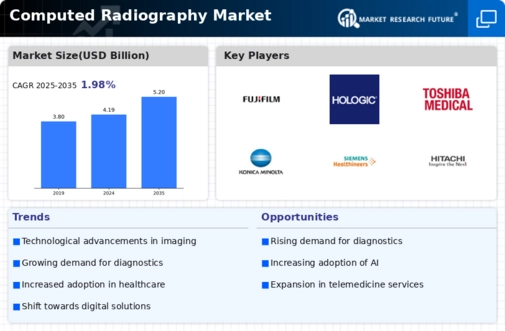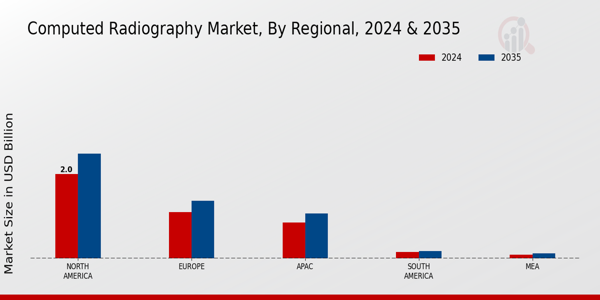Technological Advancements
The Global Computed Radiography Market Industry is experiencing a surge in technological advancements, particularly in digital imaging and processing techniques. Innovations such as improved image quality, faster processing times, and enhanced storage solutions are driving adoption across healthcare facilities. For instance, the integration of artificial intelligence in radiography systems is streamlining workflows and enhancing diagnostic accuracy. This trend is expected to contribute to the market's growth, with projections indicating a market value of 4.19 USD Billion in 2024. As technology continues to evolve, it is likely to further bolster the Global Computed Radiography Market Industry.
Rising Healthcare Expenditure
Rising healthcare expenditure globally is a significant driver for the Global Computed Radiography Market Industry. As countries allocate more resources to healthcare, there is an increasing investment in advanced diagnostic technologies, including computed radiography systems. This trend is particularly evident in emerging economies, where healthcare infrastructure is rapidly developing. The enhanced funding allows for the procurement of state-of-the-art imaging equipment, thereby improving diagnostic capabilities. Consequently, the market is expected to grow, with a projected value of 4.19 USD Billion in 2024, reflecting the positive impact of increased healthcare spending on the Global Computed Radiography Market Industry.
Regulatory Support and Standards
Regulatory support and the establishment of standards are pivotal drivers for the Global Computed Radiography Market Industry. Governments and health organizations are implementing regulations that promote the adoption of advanced imaging technologies to ensure patient safety and improve diagnostic accuracy. For example, initiatives aimed at standardizing imaging protocols across healthcare facilities are likely to enhance the reliability of computed radiography systems. This regulatory framework not only fosters trust among healthcare providers but also encourages investment in new technologies, thereby contributing to the anticipated growth of the market, which is projected to reach a CAGR of 1.98% from 2025 to 2035.
Growing Awareness of Radiology Benefits
Growing awareness of the benefits of radiology is influencing the Global Computed Radiography Market Industry positively. As healthcare providers and patients recognize the advantages of computed radiography, such as reduced radiation exposure and improved image quality, the demand for these systems is likely to increase. Educational campaigns and professional training programs are enhancing understanding among medical professionals, further driving adoption. This heightened awareness is expected to contribute to the market's growth trajectory, with projections indicating a market value of 5.2 USD Billion by 2035, underscoring the importance of radiology in modern healthcare.
Increased Demand for Diagnostic Imaging
The Global Computed Radiography Market Industry is witnessing an increased demand for diagnostic imaging services, driven by a growing emphasis on early disease detection and preventive healthcare. As populations age and the prevalence of chronic diseases rises, healthcare providers are increasingly relying on computed radiography for accurate diagnosis. This demand is reflected in the projected market growth, with an expected value of 5.2 USD Billion by 2035. The ability of computed radiography to provide high-quality images quickly and efficiently positions it as a preferred choice in various medical settings, thereby enhancing the Global Computed Radiography Market Industry.

















